Posted in Digital First Media | Leave a Comment »
The LSU Manship School of Mass Communication will also be holding a memorial service in honor of Steve at 4:30 Monday, April 3 at the Holliday Forum in the LSU Journalism Building. Further details are in the link below.
Posted in Digital First Media | 1 Comment »
We’d like to thank everyone again for the continuing love and support we’ve received since Steve’s passing. This post is to remind and provide some more details for Steve’s memorial service, which will take place at 4pm, Saturday April 8, at the Earle Brown Heritage Center in Minneapolis, MN. Directions to the venue are also on the website.
For guests arriving on Friday the 7th, we welcome you to join us at Pinstripes in Edina, MN from 5pm-7pm for bowling and other fun.
If you plan to attend either event and haven’t already been in contact with one of us, please let Mike Buttry know at mwesleybuttry@gmail.com.
Finally, there are blocks of hotel rooms available for out-of-town guests under the name “Buttry Memorial.”
- The Embassy Suites Minneapolis North is directly adjacent to the Earle Brown Heritage Center. Reservations under the block close on March 21.
- The Westin Edina Galleria is located near Mike and Susie in Edina, about 20 minutes away from the venue. Reservations under the block close on April 1.
Again, thank you for the continued love and support. While the pain of Steve’s passing is still with us, we have found genuine solace in the positive impact he’s had on so many of your lives.
Mimi, Tom, Mike and Joe
Posted in Digital First Media | 1 Comment »
The public memorial for Steve Buttry will take place on 4:00pm, Saturday, April 8th at the Earle Brown Heritage Center in Minneapolis, MN. This will be a celebration of Steve’s life and we welcome everyone who wishes to attend. We are working to set up a block of rooms at the Embassy Suites hotel adjacent to the venue, which should be available to book starting on Monday, February 27. In lieu of flowers, please contribute any memorials to the Steve Buttry Scholarship Fund at the Manship School of Mass Communications at LSU.
We would like to thank everyone for the outpouring of love and support we’ve received since Steve’s passing. We will continue to moderate and post comments (though nowhere near as rapidly as Steve would) for the next couple of weeks.
Below are the links to several touching and publicly posted tributes about Steve. These are by no means comprehensive, and of course, don’t include all of the touching personal messages and comments we’ve received in the past few days.
- One of the tributes that Steve would have loved is that his obituary led to the largest single day of traffic this site ever received (over 14,000 page views on Monday, and over 17,000 overall for his obituary so far). He also trended nationally on Twitter on Monday afternoon.
- Benjamin Mullin of Poynter collected a series of remembrances from some of Steve’s closest colleagues.
- Dan Finney, Mandy Jenkins and Kathleen Bartzen Culver wrote about Steve’s impact on their careers.
- LSU student media also covered Steve’s life and time with the university with a video segment and letter from the editor.
- Steve was also memorialized by several newspapers he either worked at, or from local communities where he was active, including the Des Moines Register, Omaha World-Herald, Cedar Rapids Gazette, Baton Rouge Advocate, and the Daily Reveille.
Again, thank you so much for all of the love and support.
Mimi, Tom, Mike and Joe
Posted in Digital First Media | Leave a Comment »
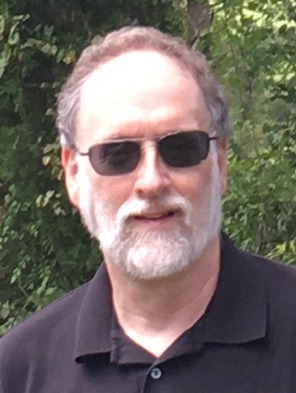
Steve Buttry
Steve Buttry, a journalist for more than 45 years, died February 19 at age 62 of pancreatic cancer, his third major cancer.
A memorial service will be held in coming weeks in Minneapolis, Minnesota. Details are pending and will be posted to this blog and other social media platforms. The family requests that memorial tributes are directed to a scholarship fund created in Buttry’s honor at the LSU Manship School of Journalism.
Buttry spent most of his career as a reporter and editor, but achieved prominence late in his career as a newsroom trainer, then as an advocate for and teacher of digital journalism and media innovation and finally for blogging openly about his cancer treatment.
His first cancer, colon cancer, was detected early and was cured by surgery in August 1999, when Buttry was a religion reporter and writing coach for the Des Moines Register. He did not need further treatment, but had a second bowel resection in 2006 after discovery of pre-cancerous lumps in his appendix and lymph nodes near the colon. Buttry joked after the surgeries about having a “semi-colon,” but was able to resume a normal lifestyle.
A second cancer diagnosis, basal-cell skin cancer, required microsurgery in 2005, but needed no further treatment. Buttry didn’t count that among his three major cancers.
In 2014, he was diagnosed with Stage IV mantle-cell lymphoma. That was cured by six rounds of heavy-duty chemotherapy, followed by a stem-cell transplant, using Buttry’s own stem cells.
In a 2014 blog post announcing the diagnosis, Buttry wrote: “If Steve Buttry Cancer 2.0 doesn’t come out the way I’m hoping, I don’t want anyone saying I ‘lost a battle’ with cancer. I kicked cancer’s ass back in 1999 and lived a wonderful 15-plus years since my first diagnosis. If my second round doesn’t end as well, I still won.”
After finishing the lymphoma treatment, a routine follow-up scan in April 2016 led to a diagnosis of pancreatic cancer, which was not related to either of the earlier cancers. The pancreatic tumor did not respond to chemotherapy and soon spread to the liver.
In his final years, Buttry’s career was recognized with three major professional awards, plus a scholarship in his name at LSU’s Manship School of Mass Communication, the last stop in his career.
Childhood
Buttry was born at Sampson Air Force Base, N.Y., on Oct. 26, 1954, the second son of Air Force Chaplain Luke Buttry and his wife, Harriet. For the next 16 years, the Buttry family lived on or near Air Force bases in Florida, England, Utah, Japan and Ohio. As an adult, Steve described his childhood as that of an “Air Force brat.” He and older brother Dan were joined by a third brother, Don, and a sister, Carol.
Steve developed severe asthma and other respiratory ailments while living in the United Kingdom. He was too sick to start school on time for English pupils but was tutored by Ellen Shaw, a retired school teacher who lived next door. “Mrs. Shaw” started the young boy on a lifelong love of reading and writing, and Buttry finished reading the Fred Gipson classic Old Yeller before starting the first grade. A painting by Mrs. Shaw, of a rural England countryside scene, hung in Buttry’s LSU office.
Buttry showed an early interest in journalism. As a fifth-grader in Utah, he listened to University of Utah basketball games on his radio (after his parents thought he had gone to bed), taking notes and writing sports stories for a newspaper of which he was the sole reader. (He could not later recall what he named the newspaper.) As a high-school freshman in 1968, Buttry started carrying the Columbus (Ohio) Citizen-Journal, waking an hour before he needed to start riding his route, so he could read the newspaper first, imagining the day he would be a journalist writing such stories.
Buttry’s first published bylines appeared in the Doubloon, the student newspaper of Reynoldsburg High School in suburban Columbus, where he was a sophomore in 1969-70. That summer he attended a high school journalism workshop at Ohio University. Both experiences cemented his ambition for a career in journalism. Buttry was also a proud Boy Scout, having earned the Eagle Scout award while in Ohio.
The Buttry family moved to Shenandoah, Iowa when Luke Buttry retired from the Air Force before Steve’s junior year of high school. The summer before Buttry’s senior year, his mother noticed in the Sentinel that Chuck Offenburger, the sports editor, was interested in hiring a high school student to work part-time covering sports. Buttry applied for the job, starting both his journalism career and a lifelong friendship with Offenburger.
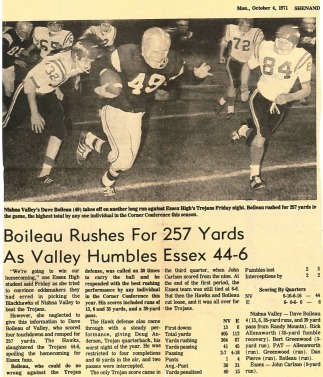 On Friday, Oct. 1, 1971, a call from an Essex High School student, Mimi Johnson, provided the most important reader feedback of Buttry’s career. She faulted his prediction that Nishna Valley would beat Essex in that evening’s game. Nishna Valley won, 44-6. Buttry and Johnson later met in person and started dating. They would be married for more than 42 years.
On Friday, Oct. 1, 1971, a call from an Essex High School student, Mimi Johnson, provided the most important reader feedback of Buttry’s career. She faulted his prediction that Nishna Valley would beat Essex in that evening’s game. Nishna Valley won, 44-6. Buttry and Johnson later met in person and started dating. They would be married for more than 42 years.
After graduating from Shenandoah High School in 1972, Buttry went to Texas Christian University on a National Merit Scholarship. He immediately started writing as a reporter for the student newspaper, The Daily Skiff. Buttry worked for the Skiff throughout his time at TCU, including two semesters as editor-in-chief.
The Buttry-Johnson romance continued when he went to Texas. They married Aug. 3, 1974, at St. Mary’s Catholic Church in Shenandoah and lived in off-campus housing his junior and senior years.
Upon graduation from TCU in May of 1976, Buttry returned to Shenandoah as a news reporter for the Sentinel. He later added the duties of editorial page editor and managing editor.
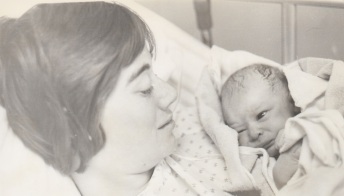
Mimi Johnson Buttry with the couple’s oldest son, Mike, shortly after birth.
Also in 1976, Mimi gave birth to their first son, Michael Wesley Buttry, born Dec. 10.
Buttry accepted a job as a copy editor for The Des Moines Register in November 1977. Though he would have preferred a reporting job at the time, he was always grateful for learning the fundamentals of journalism as a copy editor. After nearly two years on the copy desk, Buttry moved to the city desk.
The Buttrys’ second and third sons, Joseph Lucas and Thomas Stephen, were born in Des Moines, Joe on Nov. 27, 1980, and Tom on Sept. 15, 1982. Joe was born on Thanksgiving day and Tom was born 10 days before the final edition of the Des Moines Tribune, the sister evening paper to the Register.
The death of the Tribune caused considerable upheaval in the newsroom, including 15 early retirements and 55 more job cuts, but Buttry received both a pay raise and a promotion, to the chief assistant city editor, known in the newsroom as the “hot seat.” He confessed later to feeling some “survivor’s guilt” over his good fortune at a time when others were losing their jobs.
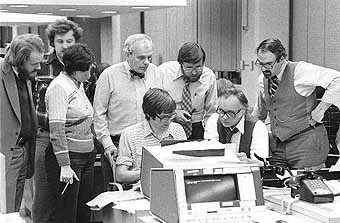
Steve Buttry, seated at computer terminal, got help on deadline in covering the 1980 Republican caucuses.
He played key editing roles in coverage of both the 1980 and ’84 Iowa caucuses. In 1983, he created “The Iowa Caucus Game,” a board game that celebrated and spoofed the quadrennial political spectacle (and the Register’s role in covering it). One of his family’s favorite photos shows Steve on caucus night in 1980, as the Register was preparing to call George H.W. Bush the winner. Top editors and reporters huddled around Buttry at an old computer terminal as he edited the story.
In 1980 and ’85, Buttry got his first experiences in two pursuits that would later become the primary focus of his career: teaching and newsroom training. He spent two winter quarters (1980-81 and ’83-84) as an adjunct journalism teacher at Central College in Pella, Iowa, and in early 1985 he spent two days visiting the St. Joseph News-Press and Gazette, in St. Joseph, Mo., as a writing coach.
In 1984, Buttry decided he wanted to move from editing to reporting. Managing Editor Arnold Garson accommodated, making Buttry a general assignment reporter covering news around Iowa. After just a few months, though, Garson had another assignment for Buttry: launching Hometown, a regional weekly section of the Register to be based in Fort Dodge, Iowa. After a successful launch of Hometown, Buttry was assigned to spend a few weeks in Mason City, Iowa, helping fine-tune the regional news operation there.
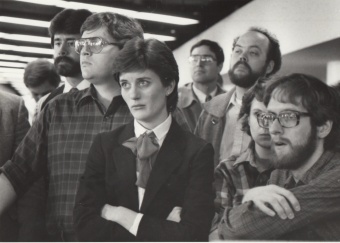
The Register newsroom learns that Gannett is buying the company, 1985. Steve Buttry is at the far right.
In March 1985, shortly after the sale of the Register to Gannett Corp. Buttry accepted an offer to become assistant national/mid-America editor at the Times, and two years later, Buttry was named to replace Rick Tapscott as national/mid-America editor.
After the evening Star and morning Times announced they would “merge” in 1990, producing a morning paper called the Star. Buttry initially was assistant managing editor/national and mid-America for the new paper, but eventually spent his last six months there as an agri-business reporter.
In July 1992, Buttry accepted the job of editor of the Minot Daily News in North Dakota, where he oversaw the newspaper’s conversion from evening to morning publication. He also got to live out every journalist’s dream of shouting, “Stop the presses!” in response to a late-breaking story, and saw his wife Mimi gain considerable local popularity as a columnist and freelance writer.
In January 1994, Buttry accepted a reporting job at the Omaha World-Herald. After spending most of his career in management, Buttry relished the reporting work. As a senior general-assignment reporter, Buttry wrote stories about a wide range of topics, including rape, abortion, girls basketball, domestic violence, government regulation, murder, the people in a historic photograph and the successful efforts by emergency workers to save 3-year-old twins who nearly froze to death.
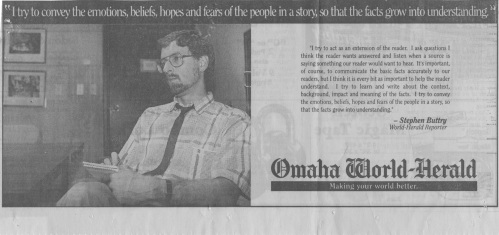
A World-Herald house ad promotes Buttry’s work.
During his time at the World-Herald in the 1990s he started learning and practicing the skills of digital journalism and he actively promoted himself as a newsroom trainer, setting the course for his later career as he continued as a reporter.
In 1997, after returning from a National Writers Workshop in the Twin Cities, Buttry decided he knew as much about journalism as the veteran editors and reporters who led sessions at the workshop and decided to seek business visiting newsrooms and journalism conferences to lead workshops on various reporting and editing skills. He decided on a few topics for workshops, developed a promotional flier and sent it out to newsrooms and press associations around the Midwest. His first client was the York News-Times in York, Neb. The North Dakota Newspaper Association also invited him up to Bismarck for a conference, and he arranged a visit to his former newsroom in Minot as part of the trip.
Rick Tapscott, the editor who hired Steve in 1985, recruited Buttry back to Des Moines as religion reporter and writing coach, including his first weekly column.
He also enjoyed formally adding training to his duties and quickly connected with a network of newsroom trainers around the world who shared tips and techniques through a list-serv and at an annual conference. He moved his workshop handouts and promotional materials to the Register’s website, where they attracted more attention.
Buttry’s first cancer diagnosis came in 1999, which was quickly treated with surgery.
In early 2000, Buttry again was involved in coverage of the Iowa caucuses, including a story that generated some national attention about the role of religion in the caucuses.
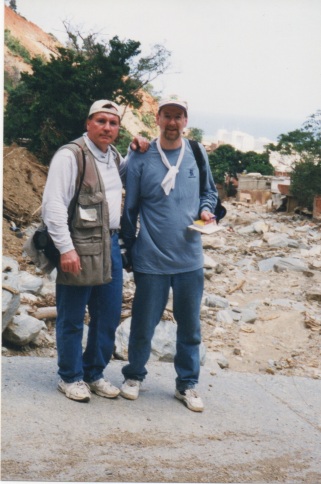
Gary Fandel and Steve Buttry on assignment in Venezuela.
Buttry’s biggest foreign reporting assignment came during his second hitch at the Register. First Assembly of God, one of Des Moines’ biggest churches, sent a mission group to Venezuela following a mudslide disaster there. Buttry persuaded Tapscott to send him along for the nine-day trip, along with photojournalist Gary Fandel.
In May 2000, Buttry agreed to return to the World-Herald as national correspondent and writing coach. The World-Herald agreed to let him train at other newspapers using vacation time and to use company time to speak to non-paying conferences at journalism organizations and press associations. Buttry spoke extensively, building an international reputation as a newsroom trainer.
At this time Buttry also joined a major newsroom trainer projects, the launch of the No Train, No Gain website to share newsroom training materials with colleagues around the world. Buttry quickly volunteered to be content coordinator for the website and posted all of his own workshop handouts on the site. He eventually added a blog about training issues, called Training Tracks.
Buttry credited NTNG with spreading his reputation as a leading newsroom trainer, and he soon was visiting several newsrooms a year to present workshops for journalists as well as training for state and regional press associations, universities and other journalism organizations.
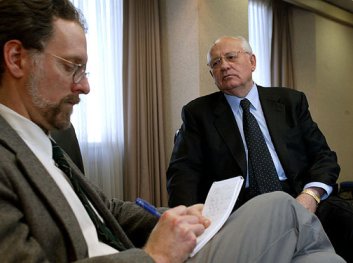
Steve Buttry interviews Mikhail Gorbachev. Photo by Kent Sievers.
Stories that dominated Buttry’s reporting in the 2000s included 9/11, the University of Nebraska at Omaha’s involvement in Afghanistan, sexual abuse by priests and a former Boys Town counselor and Omaha’s Sudanese refugee community. He also interviewed former Soviet President Mikhail Gorbachev in 2002. Buttry’s seventh time covering the Iowa caucuses included coverage of a 2004 Democrautic caucus in Council Bluffs.
The Buttry family began growing in the same decade. Mike married Susie Burke in 2003, Joe married Kim Bagby in 2007 and Tom married Ashley Douglass in 2015.
In April 2005 Buttry took a new job as director of tailored programs at the American Press Institute. At API, he worked in the Newspaper Next project, which sought to lead the industry in development of new business models.
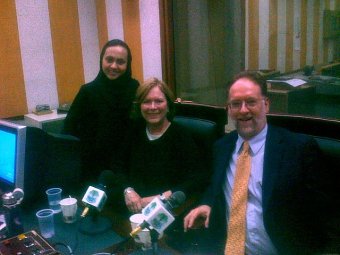
Carol Ann Riordan, center, and Steve Buttry in a radio studio following an interview on their visit to Saudi Arabia.
He wrote his first draft of a business model called A Blueprint for the Complete Community Connection while at API, proposing it as part of the Newspaper Next 2.0 report. When API decided not to include C3 in the 2.0 report, Buttry began looking for a company interested in trying the approach.
Buttry thought he had found the right home to try C3 when he accepted the job of editor of the Cedar Rapids Gazette and Gazetteonline.com (now thegazette.com). The situation at the Gazette changed dramatically Buttry’s third day as editor, June 12, 2008, when Cedar Rapids was inundated by a historic flood.
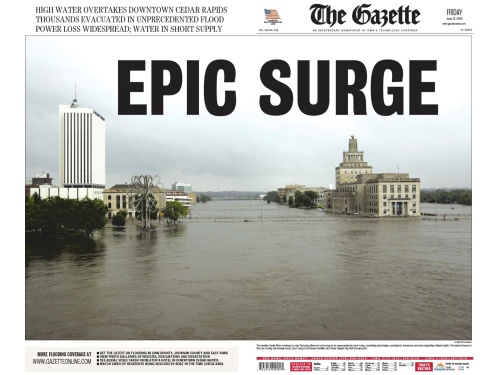
The Gazette‘s 12-column wrap-around front page on June 13, 2008.
Buttry was always proud of his staff’s excellent flood coverage, but the company’s interest in his new approach to business started waning almost immediately. What seemed like a perfect fit in May 2008 had turned into a miserable situation a year later, and Buttry was looking for his next job.
He blogged frequently, though, about issues relating to digital journalism and business models to sustain it. The blog, which he eventually called The Buttry Diary, was where he published his C3 Blueprint and a call for news organizations to pursue mobile-first strategy. The ideas drew international attention, including an invitation to teach about C3 in Siberia.
Buttry became one of journalism’s busiest bloggers, especially considering his job was never full-time blogging. In addition to the journalism blog, he launched a baseball blog, Hated Yankees, in 2009, and a travel blog, with his wife, 2 Roads Diverged, in 2012. After Mimi published her journalism novel, Gathering String, in 2012, Buttry also published a blog promoting the book. He was a regular contributor to the International News Media Association’s Culture Change blog in 2014 and a guest contributor to still more journalism blogs.
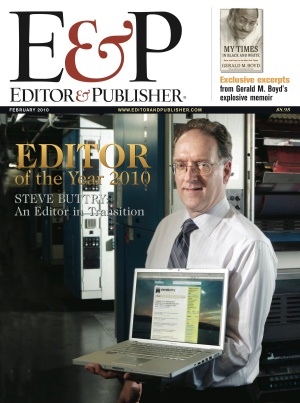 Buttry’s performance in Cedar Rapids earned him recognition from Editor & Publisher magazine as Editor of the Year. The award praised the vision outlined in C3.
Buttry’s performance in Cedar Rapids earned him recognition from Editor & Publisher magazine as Editor of the Year. The award praised the vision outlined in C3.
Fittingly, that next job was with someone Buttry knew only digitally before they met to discuss the job, Jim Brady, former executive editor of washingtonpost.com. Brady and Buttry followed each other on Twitter and were scheduled to be on a panel together at the University of Missouri in November 2009. The month before, Brady announced that he was launching a new venture covering local news in the Washington area for Allbritton Communications, owner of Politico as well as two Washington TV stations. Buttry messaged Brady that he’d like to be involved and they agreed to talk in Columbia. By February 2010, Buttry was moving to Washington to lead community engagement for the venture, which they eventually named TBD.
While in the Washington area, Buttry taught as adjunct faculty at graduate programs at Georgetown and American universities.
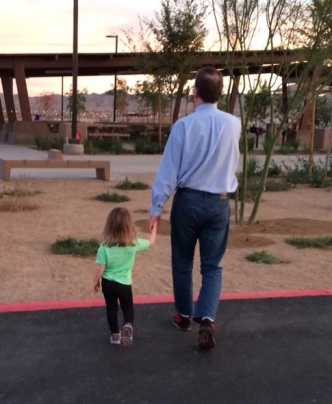
Madeline and Gramps at the park.
Buttry also became a grandfather in 2010 while in Washington, waiting at the hospital for the birth of Mike and Susie’s daughter, Julia. Buttry was a doting grandfather, known as Gramps to Julia and her sister, Madeline, born in 2012 in Edina, Minn.
Though TBD’s launch attracted considerable attention (Buttry was in charge of media relations, among other things), Brady lost an internal battle for control of the operation and left just three months after TBD launched. Brady landed quickly with the Journal Register Co., whose CEO, John Paton, wanted to transform how newspapers thought and operated. Brady soon hired Buttry to help him lead newsrooms at JRC, which became Digital First Media and took over operations of the former MediaNews Group.
Buttry visited the newsrooms of all DFM daily newspapers, visiting some of them in multiple locations as newsrooms moved as well as some weekly newsrooms. In all, he visited 84 DFM newsrooms, leading workshops for staffs as well as coaching editors and other staff members. Two primary focuses of his work at DFM were training new editors in leading Digital First newsrooms and “unbolting” newsroom culture from the newspaper factory model.
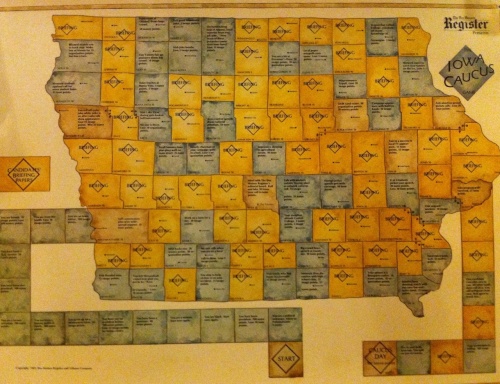
Iowa Caucus Game, 1983
The DFM experience ended when the hedge fund that controlled DFM, Alden Global, changed its strategy. Buttry’s job was cut April 2, 2014, along with other members of the company’s Thunderdome newsroom. Brady and Paton eventually left DFM as well.
The day of the Thunderdome cuts, Dean Jerry Ceppos of LSU’s Manship School of Mass Communication offered Buttry a job as Lamar Visiting Scholar. Buttry eventually accepted the job and moved full-time into academia. After initially accepting a one-year position, Buttry became the director of Student Media in 2015.
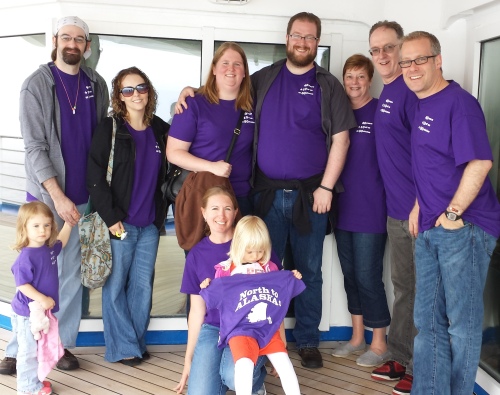
Family photo on the Alaska cruise. Standing from left, Madeline, Joe, Kim, Ashley, Tom, Mimi, Steve, Mike. In front, Susie and Julia.
Before starting the LSU job, the Buttry sons and their wives took Steve and Mimi on an Alaska cruise to celebrate their 40th wedding anniversary in August 2014, taking Buttry to his 50th state. After cruising with the whole family from Vancouver to Anchorage, the couple continued alone on a trip to Denali National Park, where they saw both clear views of the highest U.S. mountain peak, which is often shrouded in clouds, and the big-game “grand slam” of wolves, grizzly bears, moose, caribou and Dall sheep.
Another family highlight followed later in 2014, when Buttry kept a 29-year-old promise, made when he took Mimi to Game Two of the 1985 World Series. That was the Buttrys’ first year in Kansas City, and Buttry promised to take Mike the next time the Royals were in the World Series. The Royals didn’t return to the Series again until 2014, when Buttry kept his promise to Mike and took Joe and Tom to the game for good measure.
The next month, a pain in Buttry’s back and a lump in his left armpit led to a series of tests that diagnosed mantle-cell lymphoma. Chemotherapy and related medical problems, including a craniotomy to drain bleeding in his brain, took up most of 2015. However, Buttry was able to travel to Maryland to keep another vow to dance at Tom and Ashley’s wedding. The lymphoma treatment concluded with a stem-cell transplant, using Buttry’s own cells, in December 2015.
Toward the end of the stem-cell transplant recovery, Buttry received a message that provided a journalism highlight for 2016. Bridget Hegarty, a source from a 1996 story, tracked him down to thank him:
You helped give what happened to me a voice. It was a voice that I can now use, and do use every day of my life. You gave my voice confidence and reassurance when I thought that part of me was gone forever. I have always wanted to thank you for that!
Buttry used the experience to write an article for Columbia Journalism Review on the journalistic principle of “giving voice to the voiceless.”
Soon Buttry’s focus returned to medical matters, though. A routine follow-up scan in April detected problems in the pancreas and subsequent tests diagnosed him with pancreatic cancer, unrelated to the earlier cancers. Later tests showed the tumor was not responding to chemotherapy and had spread to the liver.
Buttry was honored for his contributions to journalism with three major awards in his final years: the Glamann Award from the American Copy Editors Society in 2015, the Rich Jaroslovsky Founder Award from the Online News Association in 2016 and the Chairman’s Citation from the National Press Foundation in 2017. He also will be honored with The Steve Buttry College Journalism Award by The Fourth Estate Public Benefit Corporation and the creation of the Stephen Buttry Scholarship at the Manship School. He was recognized in 2010 as a member of the Hall of Excellence at TCU’s Schieffer School of Journalism.
#OJA16 2016 Rich Jaroslovsky Award goes to @stevebuttry pic.twitter.com/vqDEkMNKD6
— ONA Newsroom (@ONANewsroom) September 18, 2016
Buttry is survived by his wife, Mimi Johnson Buttry; sons Mike, Joe and Tom; daughters-in-law Susie Burke, Kim Bagby and Ashley Douglass; granddaughters Julia Burke Buttry and Madeline Burke Buttry; mother Harriet Buttry of Lee’s Summit, Mo.; brothers Dan of Hamtramck, Mich.; and Don of Shenandoah, Iowa; sister Carol Devlin of Bolton, Vt.; and many in-laws, nieces and nephews.
— 30 —
Posted in Personal | 48 Comments »
I will be teaching a class today on updating ethical guidance for journalists. We’ll be discussing these ethics codes:
Society of Professional Journalists Code of Ethics
Poynter’s Guiding Principles for the Journalist
Radio, Television Digital News Association Code of Ethics
Online News Association’s Build Your Own Ethics Code project
 In addition, we’ll discuss these ethics projects:
In addition, we’ll discuss these ethics projects:
Telling the Truth and Nothing But
Here are some blog posts I’ve written about the codes and other projects that make some of the points I will cover in class:
New SPJ Code of Ethics: an improvement but a disappointment
New Guiding Principles for Journalists a big step forward (but they neglect linking)
ONA project provides helpful, detailed ethics advice
‘Rules of the Road’: A conversation starter on digital journalism ethics
Journalists need to use links to show our work
The Verification Handbook is now available
My version of Craig Silverman’s accuracy checklist
Here are my slides for the class:
Posted in Ethics | Tagged Build Your Own Ethics Code, ethics codes, Guiding Principles for the Journalist, journalism ethics, RTDNA Code of Ethics, SPJ Code of Ethics | Leave a Comment »
My Current story about journalism ethics in private behavior prompted a podcast on the topic by one of my former American University students. Here’s my “It’s All Journalism” podcast with Michael O’Connell:
Posted in Digital First Media | 1 Comment »
I’ve received some welcome attention from media lately, mostly because of my holiday letter, which acknowledged my terminal cancer.
Daniel Finney, a longtime friend who’s a Des Moines Register columnist, wrote his Christmas Day column about Mimi and me, after interviewing us both.
Another old friend, Paul Stevens, noted the Finney piece in his Connecting newsletter, which prompted some praise in a subsequent edition of Connecting from John Lumpkin, yet another old friend.
Next came an interview Tuesday evening with Jim Engster on the Louisiana Radio Network.
Also Tuesday, Current published a story I wrote about journalism ethics and community involvement.
Update: Sunday, Jan. Matt Hansen’s column in the Omaha World-Herald was about Mimi (and men who command women they don’t even know to “Smile!”). But I got a mention.
Posted in Digital First Media | 6 Comments »
2016 has been an outstanding year for Mimi and me.
We’ve had our disappointments, and they may be our biggest news of the year. We’ll get to them in due time.
But we regard this as an outstanding year for a whole lot of reasons. (We’re talking about the personal level here, setting aside the train wreck that was the 2016 election.) And we’re not going to let those disappointments get in the way of celebrating 2016 as it draws to a close. Some great things that happened this year:
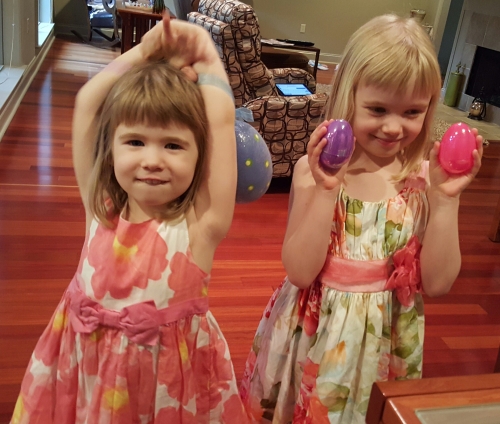
Madeline and Julia enjoyed an Easter egg hunt in our home.
Our granddaughters, Julia and Madeline, visited us along with their parents for Easter (we have a ceramic pitcher on a shelf still with a pink plastic egg resting in its head, remaining from the Easter fun; Granny and Gramps found it a few weeks after Easter and leave it there just for the smiles it brings). We visited Mike, Susie and the girls (and Joe and Kim visiting from Las Vegas) in the Twin Cities in early August, right after our 42nd wedding anniversary. Then Julia and Madeline came with their parents for another visit in early December. And we’ll be visiting them again for Christmas. What could be better than four visits with the granddaughters in a year? (Well, five, but four visits make for an outstanding year.)
We had more than 10 visits with one, two or all three of our sons. The boys and I met in Kansas City for a weekend of baseball and barbecue in June (and I managed to see both of my brothers, Mom and some friends on that trip). Mimi and I went to Washington for Thanksgiving with Tom and Ashley, with Joe and Kim joining the fun again from Vegas. And earlier in November, Tom and Ashley came down to Lexington, Va., to join me for a weekend with niece Kate and Mark Prylow and their children, when I was speaking at Washington and Lee University. Plus we had solo visits (including Joe and Kim surprising me with a visit in Baton Rouge for my birthday and Mike taking me to my first New Orleans Saints game).
We had more family visits this year, too: Mimi visited her sister, Carol, in Jacksonville, Fla., and my brother, Dan, visited us last week in Baton Rouge. My travels (more on that later) allowed me to squeeze in dinners with three of Mimi’s siblings and others family members in Iowa, Florida and Ohio. And more family visits are coming in January: my sister, Carol, and her family, and all four of Mimi’s siblings with their spouses.
#OJA16 2016 Rich Jaroslovsky Award goes to @stevebuttry pic.twitter.com/vqDEkMNKD6
— ONA Newsroom (@ONANewsroom) September 18, 2016
Professionally, this was a wonderful year for me. The Online News Association surprised me at its awards dinner in Denver with the Rich Jaroslovsky Founder Award. Friend Jim Brady (who was in on the surprise) was waiting at the next table and caught the moment on video. If you want to watch me blubbering my gratitude, go to the 50-minute mark on the video of the Online Journalism Awards. I’ll repeat more succinctly here my profound thanks to the ONA board for this career highlight. In reading about the award later, I learned that my friend Dori Maynard won the award posthumously in 2015. I am delighted to have my name associated with Dori’s and Rich’s in this way.
And just last week, I learned of another honor: I will receive the Chairman’s Citation at the National Press Foundation awards dinner in February in Washington. Chairman Kevin Goldberg chose me for the award. Again, I am deeply grateful, both for the award and for the kind praise from many after it was announced.
I know of nobody more than @stevebuttry who has carried the flame of journalistic innovation more effectively or more generously. https://t.co/MhmVSuBKxO
— (((Mark Loundy))) (@MarkLoundy) December 17, 2016
Another professional delight came in feedback from a source about a story I wrote in 1996. The source, Bridget Hegarty, actually provided the feedback in 2015, through a Facebook message on Christmas Eve, when I was still hospitalized, recovering from my stem-cell transplant. She told me that my story “helped give what happened to me a voice. It was a voice that I can now use, and do use every day of my life. You gave my voice confidence and reassurance when I thought that part of me was gone forever.” That was as strong an affirmation of my work as a journalist as I have ever received from a source. I include it in the 2016 highlights because I went back to Omaha in February for a follow-up interview and wrote a story about the experience for the Columbia Journalism Review. And Bridget gave me a shout-out last week at her graduation from nursing school.
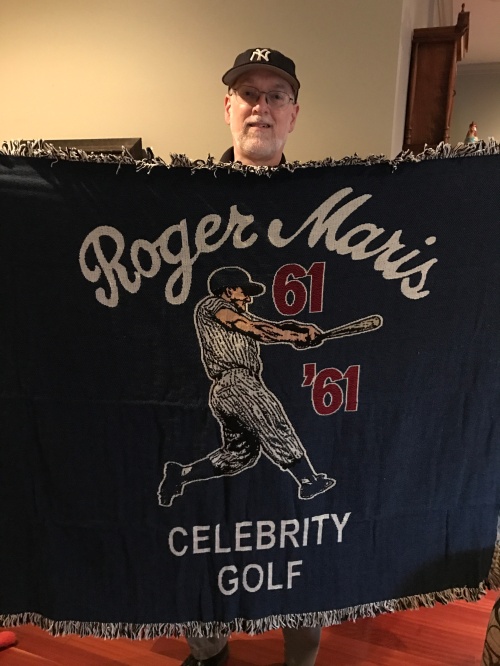
The blanket Patricia Maris gave me.
Another touching experience relating to feedback on my writing came in October, when I received a gift from Pat Maris, the widow of Roger Maris. I have written repeatedly for years about why Maris belongs in the Baseball Hall of Fame. And this fall, I learned that a grandson of Maris is in a colleague’s writing class at LSU. I shared some links to my blog posts with the grandson, and he shared them with his grandmother. And she sent me a blanket from Maris’ celebrity golf tournament. Of course, I blogged about it.
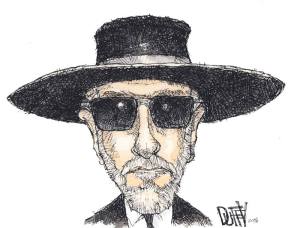 Still another highlight of the year was when Brian Duffy, my former Des Moines Register colleague and favorite editorial cartoonist, drew me for my birthday, based on my Heisenberg Twitter avatar. It has become my social media avatar and the original hangs on our dining room wall.
Still another highlight of the year was when Brian Duffy, my former Des Moines Register colleague and favorite editorial cartoonist, drew me for my birthday, based on my Heisenberg Twitter avatar. It has become my social media avatar and the original hangs on our dining room wall.
I didn’t blog as much as usual this year, because I’ve been writing letters to our sons. But my post on the newspaper industry’s defensive digital strategy created a bit of a ripple, drawing attention from the Poynter Institute, Carrie Brown-Smith, Guy Lucas, Dan Kennedy, Dan Rowinski, Tom Grubisch, Lee Procida and lots of journalists on social media. I wrote a few other posts of note during the year, wondering for The Hill about Hillary Clinton’s birthday wish list (we share a birthday) and sharing tips for localizing national and world news for the National Press Foundation.
One of my favorite writing projects for the year was a LifePost timeline about my father, Luke Buttry, who died in 1978. The project was an effort to share Dad’s story with the many grandchildren who have no memories of him (and provide a refresher for those of us with fond memories). My great-nephew (and Dad’s great-grandson) Keaton Poulter died in February at age 7, and I memorialized his short life in a Lifepost, too.
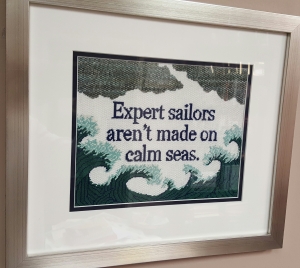 Mimi had a productive year in writing and with the needle. She got a good freelance gig for much of the year, writing questions for the weekly news quiz that was part of Reuters’ White House Run app. She also continued the needlepoint hobby that helped her get through a trying 2015. Her “Expert sailors aren’t made on calm seas” hangs above my desk.
Mimi had a productive year in writing and with the needle. She got a good freelance gig for much of the year, writing questions for the weekly news quiz that was part of Reuters’ White House Run app. She also continued the needlepoint hobby that helped her get through a trying 2015. Her “Expert sailors aren’t made on calm seas” hangs above my desk.
2016 was a good year at LSU’s Student Media, too. Student initiatives helped lead us further and faster toward a digital-first operation than I could possibly have led our students on my own. Students proposed combining our print, TV and digital operations into a single newsroom this fall and switching from a daily newspaper to a 32-page weekly, with a ramped-up digital newsroom, in the coming spring semester. The students are making great progress and plans, and we’re excited about the spring semester.
I also collaborated in the planning and presentation of Just the Facts, an American Press Institute fact-checking boot camp at LSU. In a year when facts seemed to matter so little in the presidential election, I was pleased to be swimming against the tide, exhorting journalists to check the facts and call BS on politicians and others in power. And, as an old API hand, I enjoyed collaborating with the current version of that important organization.
Chemotherapy curtailed all of my travel in 2015, except for Tom’s wedding and some Louisiana day trips. But I was free to travel extensively in 2016, free from chemo for part of the year and later taking chemo that didn’t make me as vulnerable to infections as my 2015 drugs. So I traveled. I was a keynote speaker at the Future of Student Media Summit at Ohio University in April and an ethics fellow at the 62nd Journalism Ethics Institute at Washington and Lee University in November. I spoke on panels or simply attended journalism conferences in New Orleans, Gainesville, Fla., Oklahoma City, Philadelphia and Minneapolis, in addition to ONA. I returned to TCU, my alma mater, in a faculty exchange with Steve Myers, who spoke at LSU. I flew to St. Petersburg, Fla., to lead a day of workshops for The Penny Hoarder.
A great benefit of the travel was that I had breakfast, lunch, dinner, drinks or just hallway conversations with dozens, if not hundreds, of new and old friends at the various conferences and other travels. I won’t try to name you all here (because of the certainties that I’d overlook some and that I’d bore everyone not listed). But those conversations and hugs raised my spirits again and again throughout the year. I am more grateful than I can say for my many friends and the support you have provided.
A year packed with that much joy is a terrific year, even if some heartbreak came along, too.
My two visits of the year to Mom in Kansas City were difficult. Alzheimer’s has taken not only her memory, but most of her awareness of life around her. When I visited in February, she didn’t even know I was family. Four visits over two days in June showed her in a different mental state each time, never recognizing me but a couple of times understanding that family members were visiting. She still enjoys music, even if she can no longer sing lyrics. One special moment of recognition involving my brother Don showed us that occasionally some understanding cuts through her mental fog. My older brother, Dan, visited in December for her 90th birthday and reports that on a few occasions she seemed to understand and appreciate that her Cubs finally won the World Series this year.
Again, cancer brought the year’s greatest heartbreaks.
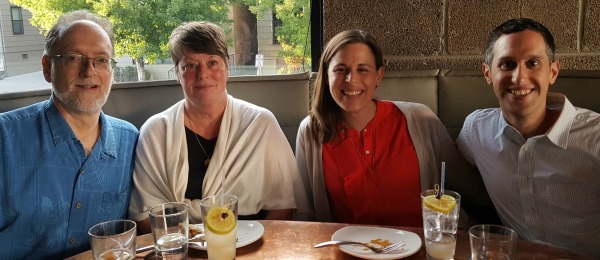
Mimi and I enjoyed dinner in Denver with Meg and Dave.
We wept over the breast cancer diagnosis of our niece and goddaughter, Meg Winter. Mimi and I were honored to preside at Meg’s wedding to Dave Winter in Colorado in 2012. Her diagnosis came shortly before ONA this year, so we were able to share hugs and dinner in Denver in September. Meg is enduring the ups and downs of chemo now, and we wish we could be there to continue supporting her in person.
And, as you may know, I had another major cancer diagnosis myself in July. This pancreatic cancer is unrelated to either of my earlier major cancers, colon cancer in 1999 and mantle-cell lymphoma in 2014-15. An edited version of my blog post about Cancer 3.0 ran on the health-care site STAT. After a few months of chemotherapy, we learned in November that the tumor is chemo-resistant. It’s growing and has spread to my liver. When I decided to stop treatment, my friend, Matt DeRienzo wrote a nice post about the Tao of Steve Buttry. I’ve been honored by lots of kind comments from friends, family and other journalists throughout my struggles with these diseases.
Cancer treatment (and the end of treatment) are tougher on a spouse than on a patient, and Mimi has been a powerful source of support and comfort through this all. Whatever lies ahead, we’re facing it together and I have the help I need. We’ve exhausted the treatment possibilities, so now I’ll just enjoy as much life as I have left, savoring every day, even the tough ones. Because I’ve seen this year that a lot of wonderful things happen even in tough times.
Posted in Personal | Tagged Brian Duffy, Bridget Hegarty, Cancer, Columbia Journalism Review, Jim Brady, Kansas City Royals, Keaton Poulter, Kevin Goldberg, Luke Buttry, Mimi Johnson, National Press Foundation, Online News Association, Pat Maris, Reuters, Rich Jaroslovsky, Roger Maris | 13 Comments »
 Twenty-five years ago, I crowdsourced the Minot Daily News’ coverage of the 50th anniversary of the attack on Pearl Harbor.
Twenty-five years ago, I crowdsourced the Minot Daily News’ coverage of the 50th anniversary of the attack on Pearl Harbor.
I didn’t call it crowdsourcing. That word was not in the journalism vocabulary back then. Neither was “community engagement.” But I knew that the community had good stories to tell, so I invited readers to tell their stories.
Most wrote with memories of where they were when they heard the tragic and historic news of the Japanese attack on U.S. naval forces in Hawaii. A few wrote of being in the military at the time and scrambling to full alert, in case other military bases were attacked. I didn’t save the coverage, but I think I recall correctly that we wrote stories on the two or three stories of local veterans who responded with first-hand accounts from Pearl Harbor.
It’s a community engagement approach that wouldn’t work as well now, on the 75th anniversary of Pearl Harbor. Surviving sailors and citizens from then would be in their 90s or older. So we have fewer now, and more of those remaining no doubt suffer from dementia that has dulled their memories or stolen them entirely. (My mother, who turned 90 this month, vividly recalled for most of her life how and when she learned of the Pearl Harbor attack, but Alzheimer’s has robbed her of that memory and many more.)
Maybe community engagement isn’t part of some magical solution to the economic woes of the news business (though I am certain it has economic value). But it was good journalism in 1991, when the 50th anniversary of Pearl Harbor was huge news. And it remains good journalism in 2016, when the 75th anniversary is noted with less fanfare.
Cancer update: I informed followers of my CaringBridge journal Monday that I am finished with treatment for my pancreatic cancer. There are no current clinical trials for my kind of cancer that has spread to the liver, and no successful treatments once it’s in the liver. So I’ve stopped treatment and will try to enjoy whatever time remains.
Posted in community engagement | 4 Comments »
I am teaching a class at Washington and Lee University today on news literacy.
We’ll be discussing fake news sites and I will be showing the students these links:
Lies, Damn Lies and Viral Content
Hyperpartisan Facebook pages are publishing false and misleading information at an alarming rate
How teens in the Balkans are duping Trump supporters with fake news
Snopes’ field guide to fake news sites and hoax purveyors
Facebook is harming our democracy and Mark Zuckerberg should do something about it
Posted in Digital First Media | 2 Comments »
I have been privileged this weekend to be an Ethics Fellow at the 62nd Journalism Institute at Washington and Lee University.
The case study I will present to students today will deal with the plagiarism case of Fareed Zakaria, which I blogged about considerably in 2014. In presenting the case to the students, I will not tell his name or the names of the journalism organizations he worked for, but will just present some of the facts of the case. Then the students will discuss what they would do if they were in charge of one of those journalism organizations.
After they discuss for a while, I will fill them in on the rest of the details of his case.
Here are the blog posts I wrote about him and his case:
Attribution, quotation marks and links: They turn plagiarism into research
Thoughts on anonymity, identification, credibility and Fareed Zakaria’s plagiarism accusers
Fareed Zakaria’s plagiarism wasn’t ‘low-level;’ no one’s is
Bloggers call out CNN for double standard on Fareed Zakaria
Newsweek, Slate and Washington Post acknowledge Zakaria’s failure to attribute
My interview with Our Bad Media on Fareed Zakaria and plagiarism
In my closing, I may talk about the importance of linking in journalism ethics, and how it might help combat and prevent plagiarism. I elaborated on that point here:
Journalists need to use links to show our work
Here’s a piece Andrew Beaujon wrote for The Washingtonian about how Zakaria paid virtually no price for his plagiarism.
Posted in Linking, plagiarism | Tagged Fareed Zakaria, linking, plagiarism | Leave a Comment »



